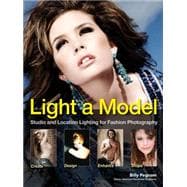Models need to get hired, designers need to sell their clothing, magazine editors need to attract readers—and to do this, they all need one thing: attention-grabbing images. Satisfying these savvy and demanding fashion-photography clients requires a photographer with both a strong command of lighting and a dash of ingenuity. In this book, veteran fashion shooter Billy Pegram (whose past clients include Fila, Swatch, Pussycat Dolls, and Tony Hawk) shows you how to attain that goal with cutting-edge techniques that showcase flawless skin, accentuate stunning figures, and highlight gorgeous products. Through careful control of the light, whether in the studio or on location, you’ll learn how to manage every nuance of the model’s appearance, drawing attention to his or her standout qualities and minimizing any problem areas. Short, to-the-point lessons with ample lighting diagrams and image sequences make learning easy. Armed with these techniques, you’ll be ready to approach fashion shoots (or fashion-inspired portrait sessions) with confidence—and deliver memorable images to your clients.








